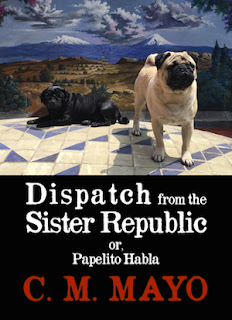Granola Shotgun on "The Springfield Strategy"
A few months back I started following Granola Shotgun by "Johnny," a self-described "amateur architecture buff a with a passionate interest in how we all live and occupy the landscape." So far his posts have been consistently informative and thought-provoking. This recent one on what Johnny terms "The Springfield Strategy" struck my gong on multiple levels: the examples of taking major life-enhancing opportunities others miss; pattern integrity versus pattern corruption / decay; and finally the views of Springfield, Massachusetts itself. (Believe it or not, Springfield makes a cameo in my book in-progress on Far West Texas. Back in ye olde day, Springfield, sprung from the
Agawam Plantation on the Connecticut River, pioneer settlement of
my just-missed-the-Mayflower ancestor, was the original bleeding edge of the Wild West.)
A fascinating podcast:
James Howard Kunstler interviews Dmitry Orlov on his book, Shrinking the Technosphere.
Orlov's
Shrinking the Technosphere is brilliant... but I remain mystified as to why he makes no mention of the works of Kevin Kelly--who also discusses the Unabomber at length in the also brilliant
What Technology Wants-- nor any reference to the
ideas of psychonaut John C. Lilly.
Orlov now blogs his lengthy, occasionally consternating, always surprising, information rich, often hilarious, and beautifully written essays behind a Patreon paywall-- not a Trumpesque impediment; a buck a month gets you in. But caveat emptor: Orlov can get waaaaay-out metaphysical-- albeit not as far into outer asteroid-belt orbits as John C. Lilly--or, not yet, anyway.
Food historian Rachael Laudan delves deeper into the
Mexico-Islamic Connection
(
Having blasted apart the story of mole, which my Mexican husband is still recovering from, she's now talking about
chicken.)
> See also Laudan's post on
When Is the Easter Bunny Not a Bunny? (most assuredly not for vegetarians).
So having spotted the review of Dr. Thoman Cowan's
Human Heart, Cosmic Heart, I dashed off an email to Lolita Lark, editor of RALPH mag and by response, ended up with a
whole page there, including links to RALPH mag's reviews of my books. Good thing my ego has a tether! P.S. I haven't scrounged up any emu oil pills yet, but yes, I am rereading Cowan. And I'm all for Dr. Cowan's
vegetable powders.
Artist and travel writer Jim Johnston looks at the
Pinta la Revolución show at Bellas Artes for his Mexico City blog.
(I saw that show myself back in March, highly recommended.)
Not far from my recent stomping grounds in El Paso,
landscape architect David Cristiani hikes Tortugas Mountain looking for cacti.
Poet and translator Patricia Dubrava on
The Little Engine That Could.
David Allen's GTD blog on
Making Use of Weird Windows of Time
How Tim Ferriss Became the Oprah of Audio. An insightful interview with the maestro of mass by Ryan Holiday for the
Observer.
(And what of
my podcasts, you might be wondering? Stay tuned.
Marfa Mondays Podcast #21, which goes to Bracketville, Texas, will be posted shortly. I guess I could call it-- taking inspiritation from
Greg Gibson's upcoming "bookectomy"--a podcastectomy. I have been working on it for too ridiculously long a time.)
And finally, just because, here in Mexico City is my writing assistant, Uli Quetzalpugtl, lifting his nose to the glory of the last of the jacaranda blossoms for this year.
 |
Uli Quetzalpugtl with the Jacaranda, Mexico City, 2017.
Photo: C.M. Mayo |
> Your comments are always welcome. Write to me
here.




























